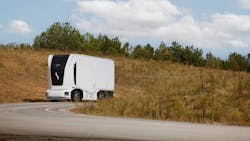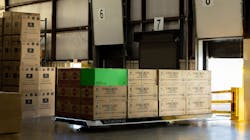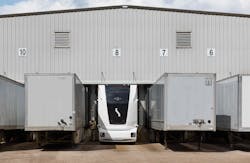Einride autonomous electric transporters join GE Appliances’ full-time fleet
Several times a day, goods are moved by truck between GE Appliances’ manufacturing facility and warehouse in Selmer, Tennessee. The distance isn’t far—just 0.3 miles—but it’s done over private roads without a human on board or any tailpipe emissions. The company still relies on veteran truck drivers, who work remotely to ensure the cab-less transporters operate safely.
After piloting Einride autonomous and battery-electric technology within a gated area in 2021 and extending it to road testing in 2022, the Haier company subsidiary fully integrated autonomous transportation into its private fleet operations.
“Our partnership with Einride in Selmer reflects our evolved approach to robotics and automation technology,” said Harry Chase, senior director of central materials at GE Appliances. “We are moving from implementing one-off solutions addressing various challenges to creating interoperability among systems that can build consistency and streamline processes in our factories and throughout our supply chain.”
See also: The humanless difference: Autonomous efficiency goes beyond fuel savings
Sweden-based freight mobility company Einride combines digital, electric, and autonomous technology into its shipping and fleet solutions offering. It has been operating in the U.S. with GE Appliances since 2019. The company’s U.S. operations are in Austin, Texas.
Henrik Green, Einride’s autonomous technologies GM, said other U.S. partnership announcements are in the pipeline. In Europe, Einride equipment is moving freight for AB InBev and Oatly. Its human-operated electric trucks are also part of Beyond Meat’s U.S. fleet.
Green said the Einride autonomous transporters are hitting all their key performance indicators for GE Appliances in Tennessee. “For the most recent days of operation, we had 100% uptime,” he told FleetOwner last week. “We have now shipped more than 1,000 units between point A to point B.”
Green, who is based in Sweden, said his company is compiling more data about the GE Appliances operation in a “live environment” as it scales up operations. He said that as the company looks at other deployments in the U.S. and Europe, Einride engineers are looking at how the GE Appliances transporters perform compared to traditional operations.
“We have plans in the pipeline,” Green said. “Of course, we're going for slightly longer distance, slightly higher speed, and step by step looking into more and more complicated use cases. But you know, safety is the priority here—and reliability and uptime.”
From truck driver to autonomous remote operator
The cab-less transporter operates autonomously but can request remote operator assistance from former over-the-road truck driver veteran Tiffany Heathcott. She was the first to move from the cab to an Einride remote operator desk in the U.S., where she has three large screens in front of her, giving a 360-degree view around the autonomous electric transporters, which Einride calls AETs.
“As the Einride AETs are completely autonomous, I’m there to help in case the ADS (automated driving system) needs guidance or assistance or in edge cases where humans can think or act better than the ADS,” she explained to FleetOwner.
From IndustryWeek: GE Appliances pilots autonomous electric vehicle for materials runs
Heathcott said she loves the remote operator job and its consistent hours, which allow her to sleep at home every night and to see her grandchildren more. And she doesn’t miss those diesel fumes and feels like she’s contributing to the future of transportation.
“Everything is much easier to use and operate than I'm used to with a normal diesel truck,” she said. “I no longer have to constantly turn my head back and forth and strain my neck to see all the necessary angles. When I was a heavy-duty truck driver, I learned to be comfortable driving large trucks by depending solely on side view mirrors. Having the additional views with the lidars and cameras helps with the gray areas that hauling trucks tend to have.”
How GE Appliances is using automation to build efficiencies
The Einride autonomous vehicle is part of a larger interoperability project in Selmer to create an automated logistics flow that improves employee ergonomics and safety around the loading docks and increases efficiency. Additional GE Appliances partners include TaskWatch and Slip Robotics.
“We believe robotics and automation technology should work with and for people to improve their jobs,” Chase said.
See also: How regulations affect the EV transition
TaskWatch’s AI cameras trigger a control board to raise and lower the dock doors and plate, lock the Einride autonomous vehicle into place, and notify the Slip robot that the vehicle is ready for loading. The robot then autonomously loads and unloads the vehicle, reducing loading times by 80%. Einride’s connectivity partner Ericsson provided the private network to ensure reliable communication between the vehicle and the remote operator on site.
“Switching to autonomous technology doesn't mean people will lose their jobs,” Heathcott noted. “In contrast to conventional trucking, remote operation will be safer, involve more regular hours, and provide a more hospitable work environment.”
Combining EV and AV technology
Several fleets and technology companies have tended to pick either electrification or automation as one path to explore this decade. But both Einride and GE Appliances have chosen to focus on both.
GE Appliances has been working to lower its carbon footprint throughout the U.S., where half of all homes contain its products. Over the last seven years, it has invested $2 billion in its nine U.S. plants and distribution centers.
GEA’s Chase said the four-day-per-week implementation in Selmer is helping his company reduce greenhouse gas emissions and allowing its employees to focus on “high-value tasks” while reducing traffic in congested areas to create safer work environments.”
See also: FedEx tests Dexterity AI’s robotic trailer loading tech
Einride’s Green sees the company’s technology becoming a valuable part of U.S. logistics and supply chains through automation and electrification. Even if a company’s specific freight lanes can’t be automated, he said Einride’s digital technology could make those routes more efficient with its electric trucks and find suitable routes for its autonomous transporters.
"Many companies are focused on either EV or AV tech without exploring the benefits of combining the two," Niklas Reinedahl, GM of North America at Einride, told FleetOwner earlier this year. "While they both provide powerful solutions on their own, Einride's pairing of EV and AV tech enables us to maximize sustainability and efficiency."
About the Author
Josh Fisher
Editor-in-Chief
Editor-in-Chief Josh Fisher has been with FleetOwner since 2017. He covers everything from modern fleet management to operational efficiency, artificial intelligence, autonomous trucking, alternative fuels and powertrains, regulations, and emerging transportation technology. Based in Maryland, he writes the Lane Shift Ahead column about the changing North American transportation landscape.



